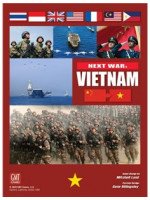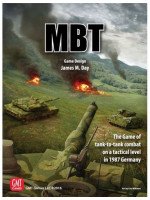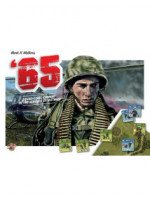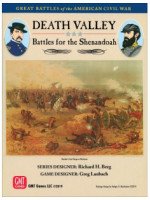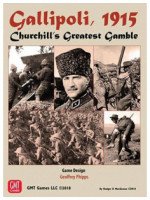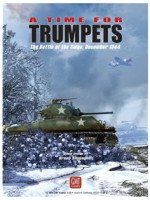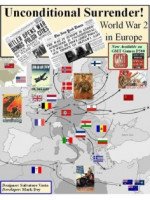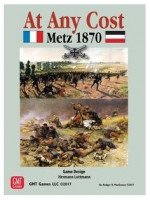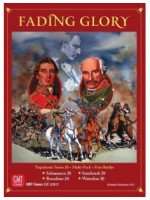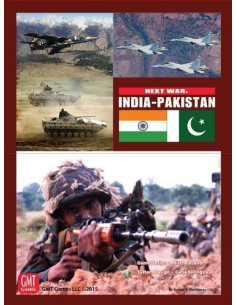
Next War: India-Pakistan
The ink was hardly dry on the documents following the partition of British India in 1947 before war broke out between India and Pakistan. Since the partition four major wars and numerous smaller conflicts have been waged over much of the same ground. In 1947 1965 1971 and 1999 India and Pakistan fought in the mountains of Kashmir and on the plains of the Punjab region to the south. Today both sides are armed with thousands of armored vehicles hundreds of advanced aircraft and dozens of nuclear weapons. With tensions high and both sides heavily armed another conflict may be just a matter of time.
Next War: India-Pakistan the next volume in GMT's series of Next War games and a follow-on to⯠Next War: Korea allows players to fight a near future war between India and Pakistan.
Due to the nature of a potential conflict only a portion of the Indo-Pakistani border is featured so that the fighting centers around what it always has: the fate of the Indian state of Jammu & Kashmir. Special rules govern such things as the expanded role bridges play in the region play as well as the fact that both sides in the conflict are nuclear-armed nations. The People's Republic of China and the United States can make an appearance but they might withdraw in the event of a nuclear exchange. The question is: will this war settle once and for all who will control northwest India?
Note: the Next War series is not an introductory wargame. Rather we have intended herein to create a system (and a series) that will allow detailed study of modern warfare in various venues as well as engaging gameplay. That said the Standard Game rules encompass a fairly straightforward rule set that will we think be considered "easy to learn" by experienced wargamers. So players who choose to play Standard Game scenarios can have a relatively quick game when that's what suits them. The real flavor of a war in the theatre however comes through in the Advanced Game where you get much more control over airpower and can more clearly see each side's strengths and weaknesses. For players who want a "mini-monster game" experience playing the Advanced Game Campaign Scenarios with some or all of the optional rules will definitely "deliver."
Ownership ofâ¯Next War: Koreaâ¯will NOT be required to play.
Units
Ground units in Next War: India-Pakistan represent the brigades support units and divisions of the armies of the India Pakistan China and the United States. All ground units are rated for their attack and defense strengths movement capabilities and unit efficiency.
Air units represent fighter bomber and attack squadrons of the major combatants and are rated for All-Weather Capabilities as well as their range average pilot skill and their abilities in Air-to-Air Combat Close Air Support and Strike missions.
Maps and Terrain
The game's map represents the area in and around the Punjab district of Pakistan and the Indian state of Jammu & Kashmir at a scale of roughly 7.5 miles per hex. The map stretches from edge of The Great Indian Desert to just inside the Himalayas and encompasses portions of both sides of the border.
Game System
A game turn is generally composed of:
Weather Determination. Bad weather can severely hamper air operations and can significantly slow ground operations.
Initiative Determination and Air/Naval Phase wherein Air Superiority levels and air availability are determined.
Special Operations Phasesâ¯in the Advanced Game allowing players to utilize their special operators in various recon and raid missions behind enemy lines.
Strike Phasesâ¯in the Advanced Game allowing players to launch air strikes cruise missiles artillery and tactical nuclear weapon strikes.
One or moreâ¯Movement and Combat Phasesâ¯that allow both sides to move react and fight with an advantage to the Initiative player on non-Contested turns
Arrival of Reinforcements and Replacements
Victory Determination
Combat
Combatâ¯resolution examines not only unit strengths but also unit efficiency (representing training doctrine and morale) as well as the terrain where the combat takes place. The CRT tends to be very bloody in nature reflecting what we believe will be a degree of attritional warfare early due to the lethality of modern weapons. As in many games casualties represent not only actual combat losses but also losses of unit cohesion brought about by the rapid pace with which modern armies are able to engage and exploit on the battlefield.
Nukes
In this in
- Deze editie is in het Engels.
- Geschikt voor 2 spelers.
- Je bent ongeveer 480 min. aan het spelen.
- Vanaf 12 jaar is dit spel te spelen.
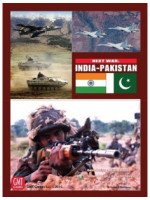
Next War: India-Pakistan
Op basis van 235 ervaringen op het toonaangevende Boardgamegeek.com
Dit spel wordt aangeraden voor (in %):
The ink was hardly dry on the documents following the partition of British India in 1947 before war broke out between India and Pakistan. Since the partition four major wars and numerous smaller conflicts have been waged over much of the same ground. In 1947 1965 1971 and 1999 India and Pakistan fought in the mountains of Kashmir and on the plains of the Punjab region to the south. Today both sides are armed with thousands of armored vehicles hundreds of advanced aircraft and dozens of nuclear weapons. With tensions high and both sides heavily armed another conflict may be just a matter of time.
Next War: India-Pakistan the next volume in GMT's series of Next War games and a follow-on to⯠Next War: Korea allows players to fight a near future war between India and Pakistan.
Due to the nature of a potential conflict only a portion of the Indo-Pakistani border is featured so that the fighting centers around what it always has: the fate of the Indian state of Jammu & Kashmir. Special rules govern such things as the expanded role bridges play in the region play as well as the fact that both sides in the conflict are nuclear-armed nations. The People's Republic of China and the United States can make an appearance but they might withdraw in the event of a nuclear exchange. The question is: will this war settle once and for all who will control northwest India?
Note: the Next War series is not an introductory wargame. Rather we have intended herein to create a system (and a series) that will allow detailed study of modern warfare in various venues as well as engaging gameplay. That said the Standard Game rules encompass a fairly straightforward rule set that will we think be considered "easy to learn" by experienced wargamers. So players who choose to play Standard Game scenarios can have a relatively quick game when that's what suits them. The real flavor of a war in the theatre however comes through in the Advanced Game where you get much more control over airpower and can more clearly see each side's strengths and weaknesses. For players who want a "mini-monster game" experience playing the Advanced Game Campaign Scenarios with some or all of the optional rules will definitely "deliver."
Ownership ofâ¯Next War: Koreaâ¯will NOT be required to play.
Units
Ground units in Next War: India-Pakistan represent the brigades support units and divisions of the armies of the India Pakistan China and the United States. All ground units are rated for their attack and defense strengths movement capabilities and unit efficiency.
Air units represent fighter bomber and attack squadrons of the major combatants and are rated for All-Weather Capabilities as well as their range average pilot skill and their abilities in Air-to-Air Combat Close Air Support and Strike missions.
Maps and Terrain
The game's map represents the area in and around the Punjab district of Pakistan and the Indian state of Jammu & Kashmir at a scale of roughly 7.5 miles per hex. The map stretches from edge of The Great Indian Desert to just inside the Himalayas and encompasses portions of both sides of the border.
Game System
A game turn is generally composed of:
Weather Determination. Bad weather can severely hamper air operations and can significantly slow ground operations.
Initiative Determination and Air/Naval Phase wherein Air Superiority levels and air availability are determined.
Special Operations Phasesâ¯in the Advanced Game allowing players to utilize their special operators in various recon and raid missions behind enemy lines.
Strike Phasesâ¯in the Advanced Game allowing players to launch air strikes cruise missiles artillery and tactical nuclear weapon strikes.
One or moreâ¯Movement and Combat Phasesâ¯that allow both sides to move react and fight with an advantage to the Initiative player on non-Contested turns
Arrival of Reinforcements and Replacements
Victory Determination
Combat
Combatâ¯resolution examines not only unit strengths but also unit efficiency (representing training doctrine and morale) as well as the terrain where the combat takes place. The CRT tends to be very bloody in nature reflecting what we believe will be a degree of attritional warfare early due to the lethality of modern weapons. As in many games casualties represent not only actual combat losses but also losses of unit cohesion brought about by the rapid pace with which modern armies are able to engage and exploit on the battlefield.
Nukes
In this in
| Naam | Next War: India-Pakistan |
|---|---|
| EAN | 817054011124 |
| Taal | Engels |
| Aantal spelers | 2 |
| Speeltijd | 480 min. |
| Minimale leeftijd | 12 jaar |
| Uitgever | GMT Games |

